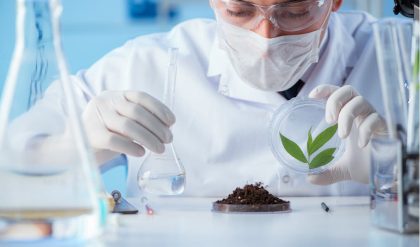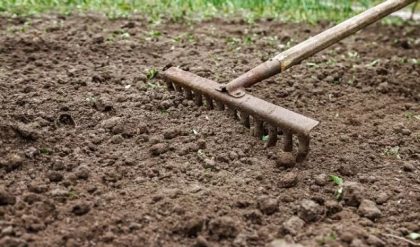The plant roots suck or extract water from the soil to live and grow. The main part of this water does not remain in the plant, but escapes to the atmosphere as vapour through the plant’s leaves and stem. This process is called transpiration. Transpiration happens mainly during the day time. Water from an open water surface escapes as vapour to the atmosphere during the day. The same happens to water on the soil surface and to water on the leaves and stem of a plant. This process is called evaporation (Fig. 4).
The water need of a crop thus consists of transpiration plus evaporation. Therefore, the crop water need is also called “evapotranspiration”.
The water need of a crop is usually expressed in mm/day, mm/month or mm/season.
Suppose the water need of a certain crop in a very hot, dry climate is 10 mm/day. This means that each day the crop needs a water layer of 10 mm over the whole area on which the crop is grown (Fig. 5). It does not mean that this 10 mm has to indeed be supplied by rain or irrigation every day.
It is, of course, still possible to supply, for example, 50 mm of irrigation water every 5 days. The irrigation water will then be stored in the root zone and gradually be used by the plants: every day 10 mm.
Fig. 4 Evapotranspiration

Fig. 5 A crop water need of 10 mm/day

The crop water need mainly depends on:
| · the climate: | for example, in a sunny and hot climate crops need more water per day than in a cloudy and cool climate (see Section 2.1) |
| · the crop type: | crops like rice or sugarcane need more water than crops like beans and wheat (see Section 2.2) |
| · the growth stage: | grown crops need more water than crops that have just been planted (see Section 2.3). |
2.1 THE INFLUENCE OF THE CLIMATE ON CROP WATER NEEDS
A certain crop grown in a sunny and hot climate needs per day more water than the same crop grown in a cloudy and cooler climate. There are, however – apart from sunshine and temperature – other climatic factors which influence the crop water need. These factors are the humidity and the windspeed (see Fig. 6). When it is dry, the crop water needs are higher than when it is humid. In windy climates the crops will use more water than in calm climates.
Fig. 6 Major climatic factors influencing crop water needs

The effect of these four climatic factors on the water need of the crop is shown in Table 1.
Table 1 EFFECT OF MAJOR CLIMATIC FACTORS ON CROP WATER NEEDS
| Climatic Factor | Crop water need | |
| High | Low | |
| Sunshine | sunny (no clouds) | cloudy (no sun) |
| Temperature | hot | cool |
| Humidity | low (dry) | high (humid) |
| Windspeed | windy | little wind |
The highest crop water needs are thus found in areas which are hot, dry, windy and sunny. The lowest values are found when it is cool, humid and cloudy with little or no wind. From the above it is clear that one crop grown in different climatic zones will have different water needs. For example, a certain maize variety grown in a cool climate will need less water per day than the same maize variety grown in a hotter climate. It is therefore useful to take a certain standard crop or reference crop and determine how much water this crop needs per day in the various climatic regions. As a standard crop or reference crop grass has been chosen.
Table 2 indicates the average daily water needs of this reference grass crop. The daily water needs of the grass depend on the climatic zone (rainfall regime) and daily temperatures.
Table 2 AVERAGE DAILY WATER NEED OF STANDARD GRASS DURING IRRIGATION SEASON
| Climatic zone | Mean daily temperature | ||
| low | medium | High | |
| (less than 15°C) | (15-25°C) | (more than 25°C) | |
| Desert/arid | 4-6 | 7-8 | 9-10 |
| Semi arid | 4-5 | 6-7 | 8-9 |
| Sub-humid | 3-4 | 5-6 | 7-8 |
| Humid | 1-2 | 3-4 | 5-6 |
For example, the standard grass crop grown in a semi-arid climate with a mean temperature of 20°C needs approximately 6.5 mm of water per day. The same grass crop grown in a sub-humid climate with a mean temperature of 30°C needs some 7.5 mm of water per day.
This daily water need of the standard grass crop is also called “reference crop evapotranspiration”.
What will be discussed in the next section is “how do the water needs of the crops grown on, for an example, an irrigation scheme relate to the water need of the standard grass”.
2.2 INFLUENCE OF THE CROP TYPE ON THE CROP WATER NEEDS
The influence of the crop type on the crop water need is important in two ways:
1. The crop type has an influence on the daily water needs of a fully grown crop; i.e. the peak daily water needs: a fully developed maize crop will need more water per day than a fully developed crop of onions.
2. The crop type has an influence on the duration of the total growing season of the crop. There are short duration crops, e.g. peas, with a duration of the total growing season of 90-100 days and longer duration crops, e.g. melons, with a duration of the total growing season of 120-160 days. And then there are, of course, the perennial crops that are in the field for many years, such as fruit trees.
While, for example, the daily water need of melons may be less than the daily water need of peas, the seasonal water need of melons will be higher than that of beans because the duration of the total growing season of melons is much longer.
The influences of the crop type on both the daily and seasonal crop water needs are discussed in the sections below.
Influence of Crop Type on the Daily Crop Water Needs
In the previous section it has been indicated how the daily water need of standard grass can be estimated. In this section it will be explained how the daily water needs of other crops can be estimated using as a basis the daily water need of the standard grass. It will be easy to understand that a fully grown maize crop – with its large leaf area – will use more water per day than, for example, a fully grown crop of radishes or onions; that is when the two crops are grown in the same area. When determining the influence of the crop type on the daily crop water needs, reference is always made to a fully grown crop; the plants have reached their maximum height; they optimally cover the ground; they possibly have started flowering or started grain setting. When the crops are fully grown their water need is the highest. It is the so-called “peak period” of their water needs.
For the various field crops it is possible to determine how much water they need compared to the standard grass (Fig. 7). A number of crops need less water than grass, a number of crops need more water than grass and a number of crops need more or less the same amount of water as grass.
Fig. 7 How much water does maize need, compared to the standard grass?
Table 3 indicates five groups of crops. The crops in column 1 need 30 percent less water than grass in their peak period. The crops in column 2 need 10 percent less water than grass. The crops in column 3 need the same amount of water as grass. The crops in columns 4 and 5 need respectively 10 and 20 percent more water than grass in their peak period.
Table 3 CROP WATER NEEDS IN PEAK PERIOD OF VARIOUS FIELD CROPS AS COMPARED TO STANDARD GRASS
| Column 1 | Column 2 | Column 3 | Column 4 | Column 5 |
| -30% | -10% | same as standard grass | + 10% | +20% |
| citrus | cucumber | carrots | barley | paddy rice |
| olives | radishes | crucifers (cabbage, cauliflower, broccoli, etc.) | beans | Sugarcane |
| grapes | squash | lettuce | maize | Banana |
| melons | flax | nuts & fruit trees with cover crop | ||
| onions | small grains | |||
| peanuts | cotton | |||
| peppers | tomato | |||
| spinach | eggplant | |||
| tea | lentils | |||
| grass | millet | |||
| cacao | oats | |||
| coffee | peas | |||
| clean cultivated nuts & fruit trees e.g. apples | potatoes | |||
| safflower | ||||
| sorghum | ||||
| soybeans | ||||
| sugarbeet | ||||
| sunflower | ||||
| tobacco | ||||
| wheat |
EXAMPLE
Suppose in a certain area the standard grass crop needs 5.5 mm of water per day.
Then, in that same area, maize will need 10% more water. Ten percent of 5.5 mm = 10/100 × 5.5 = 0.55 mm. Thus maize would need 5.5 + 0.55 = 6.05 or rounded 6.1 mm of water per day.
QUESTION
Estimate the water needs of citrus, bananas, onions, cucumber, clean cultivated apple trees and millet for an area where the water need of standard grass is 6.0 mm/day.
ANSWER
| Citrus: | -30% (compared to grass); thus the water need of citrus is 6.0 – 30% = 6.0 -1.8 = 4.2 mm/day |
| Bananas: | +20%; thus the water need of bananas is 6.0 + 20% = 6.0 + 1.2 = 7.2 mm/day |
| Onions: | same as grass; thus the water need of onions is 6.0 mm/day |
| Cucumber: | -10%; thus the water need of onions is 6.0 – 10% =6.0-0.6 =5.4 mm/day |
| Apples (clean): | same as grass; thus the water need of clean cultivated apples is 6.0 mm/day |
| If the apples have a cover crop in between the trees, the water need would be 20% higher than grass and thus: 6.0 + 20% = 6.0+1.2 = 7.2 mm/day. | |
| Millet: | +10%; thus the water need of millet is 6.0 + 10% =6.0+0.6 = 6.6 mm/day |
Influence of Crop Type on the Seasonal Crop Water Needs
The crop type not only has an influence on the daily water need of a fully grown crop, i.e. the daily peak water need, but the crop type also has an influence on the duration of the total growing season of the crop, and thus on the seasonal water need. Data on the duration of the total growing season of the various crops grown in an area can best be obtained locally. These data may be obtained from, for example, the seed supplier, the Extension Service, the Irrigation Department or Ministry of Agriculture. The duration of the total growing season has an enormous influence on the seasonal crop water need. There are, for example, many rice varieties, some with a short growing cycle (e.g. 90 days) and others with a long growing cycle (e.g. 150 days). This has a strong influence on the seasonal rice water needs: a rice crop which is in the field for 150 days will need in total much more water than a rice crop which is only in the field for 90 days. Of course, for the two rice crops the daily peak water need may still be the same, but the 150 day crop will need this daily amount for a longer period. The time of the year during which crops are grown is also very important. A certain crop variety grown during the cooler months will need substantially less water than the same crop variety grown during the hotter months.
Table 4 gives some Indicative values or approximate values for the duration of the total growing season for the various field crops. It should, however, be noted that these values are only rough approximations and it is much better to obtain the values locally.
Table 4 INDICATIVE VALUES OF THE TOTAL GROWING PERIOD
| Crop | Total growing period (days) | Crop | Total growing period (days) |
| Alfalfa | 100-365 | Millet | 105-140 |
| Banana | 300-365 | Onion green | 70-95 |
| Barley/Oats/Wheat | 120-150 | Onion dry | 150-210 |
| Bean green | 75-90 | Peanut/Groundnut | 130-140 |
| Bean dry | 95-110 | Pea | 90-100 |
| Cabbage | 120-140 | Pepper | 120-210 |
| Carrot | 100-150 | Potato | 105-145 |
| Citrus | 240-365 | Radish | 35-45 |
| Cotton | 180-195 | Rice | 90-150 |
| Cucumber | 105-130 | Sorghum | 120-130 |
| Eggplant | 130-140 | Soybean | 135-150 |
| Flax | 150-220 | Spinach | 60-100 |
| Grain/small | 150-165. | Squash | 95-120 |
| Lentil | 150-170 | Sugarbeet | 160-230 |
| Lettuce | 75-140 | Sugarcane | 270-365 |
| Maize sweet | 80-110 | Sunflower | 125-130 |
| Maize grain | 125-180 | Tobacco | 130-160 |
| Melon | 120-160 | Tomato | 135-180 |
As can be seen from Table 4 there is a large variation of values not only between crops, but also within one crop type. In general it can be assumed that the growing period for a certain crop is longer when the climate is cool and shorter when the climate is warm.
INFLUENCE OF THE GROWTH STAGE OF THE CROP ON CROP WATER NEEDS
A fully grown maize crop will need more water than a maize crop which has just been planted. As has been discussed before, the crop water need or crop evapotranspiration consists of transpiration by the plant and evaporation from the soil and plant surface. When the plants are very small the evaporation will be more important than the transpiration. When the plants are fully grown the transpiration is more important than the evaporation.
Figure 8 shows in a schematic way the various development or growth stages of a crop.
Fig. 8 Growth stages of a crop

At planting and during the initial stage, the evaporation is more important than the transpiration and the evapotranspiration or crop water need during the initial stage is estimated at 50 percent of the crop water need during the mid – season stage, when the crop is fully developed.
During the so-called crop development stage the crop water need gradually Increases from 50 percent of the maximum crop water need to the maximum crop water need. The maximum crop water need is reached at the end of the crop development stage which is the beginning of the mid-season stage.
With respect to the late season stage, which is the period during which the crop ripens and is harvested, a distinction can be made between two groups of crops:
Fresh harvested crops: such as lettuce, cabbage, etc. With these crops the crop water need remains the same during the late season stage as it was during the mid-season stage. The crops are harvested fresh and thus need water up to the last moment.
Dry harvested crops: such as cotton, maize (for grain production), sunflower, etc. During the late season stage these crops are allowed to dry out and sometimes even die. Thus their water needs during the late season stage are minimal. If the crop is indeed allowed to die, the water needs are only some 25 percent of the crop water need during the mid-season or peak period. Of course, no irrigation is given to these crops during the late season stage.
DETERMINATION OF CROP WATER NEEDS
In the previous sections it has been explained on which factors – the climate, the crop type and the growth stage – the crop water need depends. To calculate the water needs for the various months during which the crop is grown is fairly complicated and explained in Part II of this manual. As stated before, it is often possible to obtain data on crop water needs locally and it is thus not necessary to calculate them. However, to give the reader some idea on values of seasonal water needs for the most important field crops. Table 5 can be used as a guide.
Table 5 APPROXIMATE VALUES OF SEASONAL CROP WATER NEEDS
| Crop | Crop water need (mm/total growing period) |
| Alfalfa | 800-1600 |
| Banana | 1200-2200 |
| Barley/Oats/Wheat | 450-650 |
| Bean | 300-500 |
| Cabbage | 350-500 |
| Citrus | 900-1200 |
| Cotton | 700-1300 |
| Maize | 500-800 |
| Melon | 400-600 |
| Onion | 350-550 |
| Peanut | 500-700 |
| Pea | 350-500 |
| Pepper | 600-900 |
| Potato | 500-700 |
| Rice (paddy) | 450-700 |
| Sorghum/Millet | 450-650 |
| Soybean | 450-700 |
| Sugarbeet | 550-750 |
| Sugarcane | 1500-2500 |
| Sunflower | 600-1000 |
| Tomato | 400-800 |



Comments are closed.